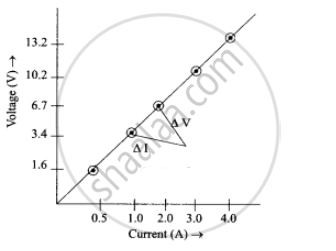Advertisements
Advertisements
प्रश्न
Exercise.
The values of current (I) flowing through a resistor for various potential differences V across the resistor are given below. What is the value of resistor?
| I (ampere) | 0.5 | 1.0 | 2.0 | 3.0 | 4.0 |
| V (volt) | 1.6 | 3.4 | 6.7 | 10.2 | 13.2 |
उत्तर

Resistance(R) = \[\frac{\text{∆V}}{\text{∆I}}\]
= 10.2 – `"6.7"/"3"` – 2 = 3.5/1
R = 3.5Ω
APPEARS IN
संबंधित प्रश्न
The effective resistance of three resistors connected in series is lesser than the lowest of the individual resistances.
What is resistance?
The resistance of a straight conductor is independent of ______.
What is the maximum resistance one can make with ten 1Ω resistors?
Resistors are connected in series if the resistance of the electric circuit is to be ______.
Three resistors are connected in parallel with a battery. If the current in each resistor is 2A, then the current through the battery will be ______.
Define the following:
Fixed resistor
Define the following:
Variable resistor
|
5 bulbs are connected in series in a room. One bulb is fused. It is removed and remaining 4 bulbs are again connected in series to the same circuit. What will be the effect on the following physical quantities? (Increases, Decreases, Remain Same). |
- Resistance
- Intensity of light
Define the term resistance.
